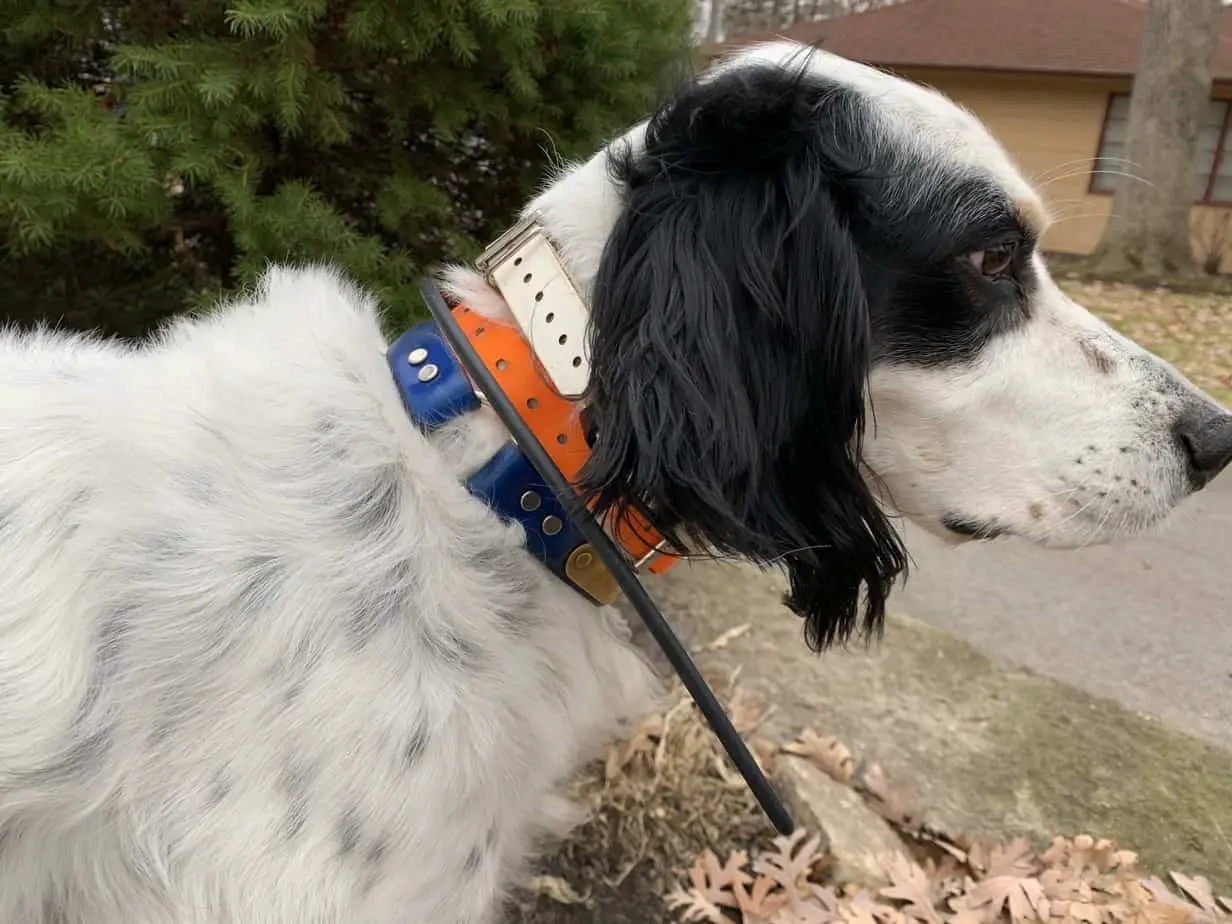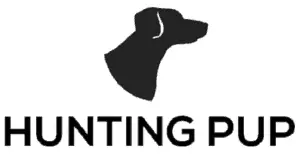
You might have seen a hunting dog with multiple collars around its neck while perusing a magazine stand, flipping passed the outdoor channel or maybe even driving past a truck on a rural dirt road. Needing multiple collars is common in the hunting dog world. It’s not uncommon to see a pointing dog holding point over a bird or hounds baying at trees either with several collars wreathed around their neck.
This may leave you wondering, why do hunting dogs wear multiple collars? The answer: each collar has a different purpose. Often a hunting dog will be wearing as many as three collars with the following uses.
- A traditional collar – allows a leash or tie out to be attached and has tags with a contact number if the dog is lost and recovered by a stranger.
- An e-collar – lets the dog’s handler correct the dog at a distance or use a tone or vibration on the collar to recall the dog if it were to range too far.
- A locating collar – such as a gps, tracking, or beeper collar used to help locate a dog that is out of sight, be it in heavy cover or at a great distance.
Lets take a deeper look at each one of these collar types to help understand their use.
Traditional Collar Use
Likely this is the collar you are familiar with, as this collar shares a lot in common with normal pet collars. The uses are the same: allowing the dog’s handler to attach a leash to the dog or attach the dog to a stake out to keep it from ranging when not hunting. The traditional hunting dog collar often has some key differences from a normal pet collar.
First, hanging metal tags with the dog’s name or owners contact information are often replaced on hunting dog collars with metal plates riveted to the side of the collar. This is done so that there less chance the collar will be snagged on these hanging metal tags as the dog works through heavy cover. It is also common practice not to include the dogs name on the collar, instead opting for just including the owners contact information. A well-trained hunting dog is quite valuable. It is thought that a dishonest party recovering a dog will be less likely to return the dog once it proves well-mannered in obeying commands by its name. So it is best not to include the dogs name on its collar and hope the recovering party mistakes the dog for an untrained mongrel and calls immediately to return the dog.
Hunting dog collars are often made of leather or poly-coated nylon vs the cotton or nylon of normal pet collars. Hunting dogs are often out in the elements in a variety of conditions. Collar made out of leather or poly-coated nylon are more durable then traditional dog collar materials and are less prone to smelling after repeatedly getting wet and dirty.
Lastly, collars with center rings are popular with hunting dogs as they allow for very easy leash attachment. The center ring naturally rides on the top of the dogs neck, allowing for easy access to leash the dog versus trying to reach under a stinky wet dog’s neck to try to find the d-ring of a traditional collar to attach a leash.
Click here to see a example of common hunting dog collar configuration on Amazon.
E-Collar Use
E-collars are commonly used with hunting dogs. These collars have a device attached to the collar around the dog’s neck with a remote carried by the dog’s handler. This device on the dogs neck usually has multiple functions such as vibration, tone (noise) or shock that can be activated by the handler via the remote. The e-collar is often worn high and tight on the dogs neck allowing the probes that deliver the shock to be pressed firmly to the dogs skin. The e-collar allows the handler to control or communicate with the dog at a distance. For example, the tone or vibration features can be taught to the dog as a recall command and can be used in place of a whistle or call to have the dog return to the handler. The shock can be used to correct misbehavior or dissuade a dog in a dangerous situation: stopping a dog from chasing a deer across a busy highway or starting a fight with a porcupine.
E-collars are often seen by the uninformed as inhumane, and if miss-used they certainly can be. However, when properly used as a correction, the shock is at a low level and results in a tickle to the dog’s neck. In an emergency, a correction from an e-collar can also save a dog’s life, as in the example of stopping a dog from running into a busy highway. Popular e-collar brands for hunting dogs include TriTronics (now Garmin), SportDog and Dogtra. Each company has a slightly different set of features and functions and a dedicated following of users devoted to their brand.
Locating Collar Use
These collars (GPS, Tracking and Beeper) all have the same purpose, but go about it in different ways.
Tracking collars have been used on hunting dogs for a long time. The technology started with telemetry collars used to track far ranging hounds as they trailed bears, raccoons, mountain lions and other game. Dogs on scent trails of these animals can range miles ahead of their handler before finally treeing or cornering the game. This is far outside the ability of the handler to hear the dogs barking and leaves him with no other way to locate the dogs without these devices. These types of collars allow the handler to find which direction to travel to find the dogs. The collar on the dog’s neck are equipped with a transmitter and the handler is equipped with a device that looks like an old TV antenna. By sweeping the antenna from side to side, the handler can locate the direction of the dog by listening for a beep from the antenna device as it is sweep past the direction of the dog. The strength of the beep can be used to gauge distance. Strong beeps indicate a closer dog and distance beeps for further dogs. These collars are prized for their long battery life (usually lasting days) and ability to locate dogs at very long range, often miles away from the handlers location.
GPS collars are newer to the scene. These collars have a GPS unit attached to the dog’s collar. The handler then carries a handled GPS unit. The unit on the dogs collar communicates with the handheld gps unit carried by the handler and places the location of the dog on the maps on the handheld unit. This allows the handler to keep track of far ranging dogs or recover a lost dog. These GPS collars have additional features, including being able to track the distance the dog traveled in a day, which aids the handler is gauging the dogs level of exertion. The system also tracks a map of the route the dog covered as well as the route of the handler, making it easy to see ground that both have missed which might hold game. Also, the system allows the handler to mark locations where game was found to analyze later or to return to on subsequent trips. GPS collars clearly have their lower tech tracking collars beat of features, but due to the tracking collars longer battery life and greater tracking distance, I would still consider tracking collars superior on the highest priority feature: being able to locate a lost dog.
Beeper collars are most popularly used with pointing and flushing dog breeds and can be configured in a few ways to help the handler keep track of their dog. First, it can be configured to emit a tone from the collar around the dog’s neck on a set interval, every 5 or 10 seconds. This way in heavy cover the handler can keep tabs on their dog’s movement by listening for the tone. This configuration is common with flushing dogs. The second beeper collar configuration is more common with pointing dogs and that is to have the collar silent until the dog goes on point, then the collar emits a sound letting the handler know to make haste to where the dog has found game. In this configuration, some collars are configured to emit the sound of a hawk scream when the dog is on point. This has the added benefit of making the birds less likely to run or fly because they believe a hawk is overhead ready to attack at their slightest movement. The third configuration is a combination of the first two, where a tone can be emitted every 5-10 seconds while the dog is moving and the tone switches to a different sound such as a hawk scream when the dog goes on point.
Why not one collar with all these functions?
There have been recent changes in the hunting dog collar market that are starting to combine these functions into a single collar and drive down the number of collars a dog is required to wear. Garmin, a big name in GPS technology, acquired a leading e-collar brand TriTronics and quickly started producing e-collars with GPS functionality included in a single collar unit. The other e-collar brands quickly followed suit and similar offerings are available from SportDog and Dogtra. However, these combination collars have some drawbacks. First, the collars are quite expensive. Second, these collars combine the e-collar features and the gps features onto a single battery. This reduces battery life of either feature and the collar running out of batteries results in a handler that cannot use either the gps or e-collar features. If the dog is lost with a dead gps/e-collar, the handler loses two methods to recover the dog: locating it via gps or using the e-collar features that the handler may have used to train the dog to return. Even with those drawbacks, as costs come down I would not be surprised to see a greater number of these combination collars on hunting dogs.
Does it bother the dog to wear so many collars?
Hunting dogs do not seem to notice having all these collars on their neck. These are highly driven dogs, participating in an activity that captures all their attention. They have incredibly high drive to hunt and it can be quite difficult to distract them from the act of hunting. Certainly a few extra collars will not slow down a high drive hunting dog.
Does wearing so many collars have any risks to the dog?
Yes, with so many collars the dog has a risk of being snagged in heavy cover. This could result in a dog being trapped by its collar due to a snag. The largest risk is to waterfowl dogs and often hunters will remove all collars from waterfowl dogs to reduce the risk of a dog being snagged by its collar and drowning.
